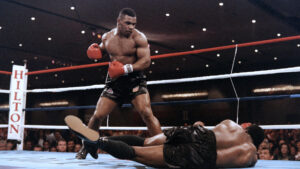Complete Guide to Boxing Terminology: From Basic Stances to Techniques and Match Rules!
Have you ever had a hard time because of unfamiliar terms when watching a boxing match or accessing related information? In this article, we will help you understand all the terms related to boxing, from basic boxing stances to major techniques, match styles, rules, and weight classes.
1. Basic Boxing Stance and Style
Orthodox
This is the basic stance for right-handed boxers. The left foot is in front and the right hand is behind, allowing for powerful punches with the right hand.
Southpaw (Southpaw)
This is the stance of a left-handed boxer. The right foot is in front and the left hand is behind. This style is considered difficult for right-handed fighters to handle.
Stance
It refers to the basic stance of the feet and body that a boxer takes when preparing to fight. A stable stance is the basis for effective attack and defense.
2. Main types of punches in boxing
Jab (jab)
A straight punch that is quickly and lightly thrust with the front hand (left hand for orthodox, right hand for southpaw). It is used for various purposes such as controlling distance, keeping an opponent in check, and starting an attack.
Cross (Cross)
A strong straight punch with the hand behind (orthodox right hand, southpaw left hand). It has more destructive power than the jab and is used as a main attack technique.
Hook (Hook)
A punch that swings the arm sideways. It is mainly used to attack the opponent's chin or side, and can be a threatening punch depending on the angle.
Uppercut (Uppercut)
An upward punch from below, mainly aimed at the underside of the opponent's chin. It has strong destructive power, so it is often used when aiming for a KO.
Body shot (body shot)
A punch that attacks the opponent's torso, such as the abdomen or sides. It is effective in accumulating damage and slowing down the opponent's movements.
Overhand (Overhand)
A punch that is usually thrown in a large arc from top to bottom with the hand behind it. It is difficult to predict and can have a powerful impact.
Check hook (Check hook)
This is a hook that you hit while rotating around your feet to dodge when your opponent comes in to attack. It is a technique that performs both defense and attack at the same time.
Counter punch (counter punch)
A punch that counters immediately after or at the moment when the opponent attacks. Timing and accuracy are important.
3. Boxing match format and judging
KO (Knockout)
In a boxing match, if the opponent does not get up by the time the referee's count ends (usually 10 seconds), the match ends and the downed fighter loses.
TKO (Technical Knockout)
This is when the referee decides that one player can no longer continue the match, or stops the match due to injury, etc. Sometimes the match is stopped in a corner.
UD (Unanimous Decision)
This means that all three judges have decided that one player is the winner.
SD (Split Decision)
This is when two of the three judges decide one player as the winner, and the remaining one decides the other player as the winner.
MD (Majority Decision)
This is when two of the three judges decide one player as the winner, and the remaining one decides it as a draw.
Draw
This is when the judges' scoring results show that neither player has a winner.
RTD (Retired)
This is when a fighter retires between rounds, or the fight is stopped in the corner for the safety of the fighter.
4. Boxing match rules and structure
Round (round)
A time unit for a boxing match. Professional matches usually last from 4 to 12 rounds, each of which is 3 minutes long. There is a 1-minute rest period between rounds.
Bell (Bell)
A bell that signals the start and end of each round.
Corner
The area of the court where players rest between rounds and receive instruction from coaches. Each player is assigned either a red corner or a blue corner.
Referee
A referee is someone who conducts the game on the field, judges violations of the rules, and is responsible for the safety of the players.
Scorecard
This is a scorecard where the judges score the players' performances for each round. After the match ends, these scorecards are added up to determine the winner.
10-point must system
A scoring system used in most professional boxing, where the better fighter in each round is awarded 10 points, and the loser is given a score of 9 or lower. If a round ends without a clear winner, both fighters can be awarded 10 points.
5. Fouls and Warnings
Low blow (low blow)
It is a foul that strikes the opponent below the belt line.
Rabbit punch (rabbit punch)
A very dangerous and forbidden punch that hits the back of the opponent's head.
Clinch (Clinch)
An act of holding an opponent's body to block an opponent's attack or to temporarily stop the match. Excessive clinching may result in a warning from the referee.
Holding
It is a foul play that involves grabbing an opponent's arm or body and preventing them from moving.
Headbutt (Headbutt)
A foul is an intentional or accidental headbutt. Intentional headbutts are subject to a point deduction.
6. Weight Class
- Flyweight: Up to about 50.8 kg (112 lbs)
- Bantamweight: Up to about 53.5 kg (118 lbs)
- Featherweight: Up to about 57.2 kg (126 lbs)
- Lightweight: About 61.2 kg (135 pounds) or less
- Welterweight: Up to about 66.7 kg (147 pounds)
- Middleweight: Up to about 72.6 kg (160 lbs)
- Light Heavyweight: Up to about 79.4 kg (175 pounds)
- Cruiserweight: Up to about 90.7 kg (200 lbs)
- Heavyweight: Over 90.7 kg (200 lbs)
(Note: Weight class standards may vary slightly from group to group.)
7. Other terms
Ring (Ring)
A square arena where boxing matches take place, usually surrounded by ropes and poles.
Undercard (Undercard)
A general term for several matches held before the main event.
Main Event
It refers to the most important and noteworthy match of the day.
Pound for Pound (P4P)
It is a concept of ranking boxers of all weight classes based solely on their skills, without considering differences in weight class.
Footwork (Footwork)
It is a technique to control distance by using foot movement and secure a position advantageous for attack and defense.
Slip
This is a defensive technique where you slightly move your head and upper body to escape the trajectory of an opponent's punch.
Weaving
A defensive technique that involves shaking the upper body from side to side to avoid an opponent's punches. It is mainly used to avoid hooks or uppercuts.
Feint (Paint)
A fake attack move thrown to deceive the opponent. Used to induce a reaction from the opponent or to make them let their guard down.
Cutman (Cutman)
A team member who treats and manages injuries to players' faces and other areas between rounds.
Corner man (cornerman)
A team member who supports players by giving them advice, guiding them in strategy, and encouraging them between rounds.


